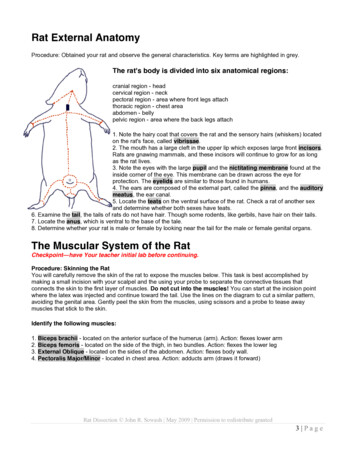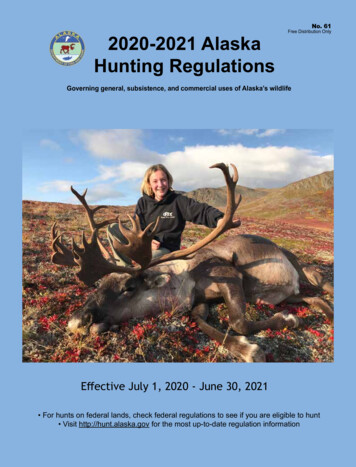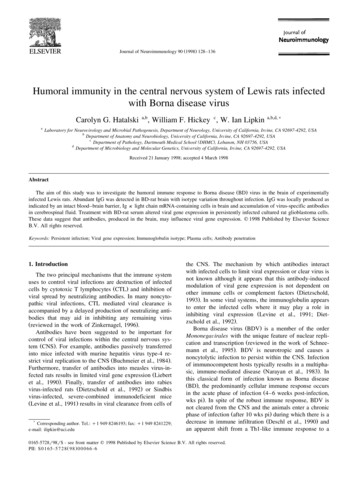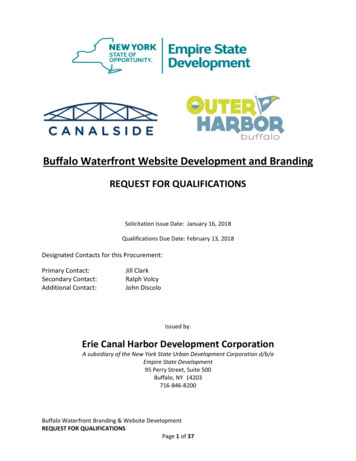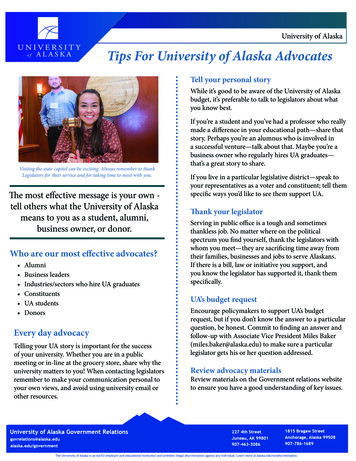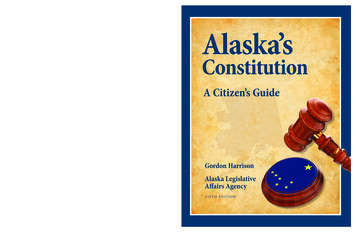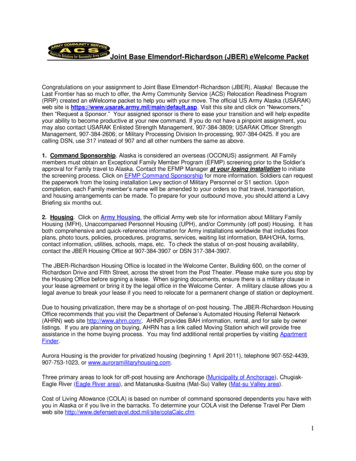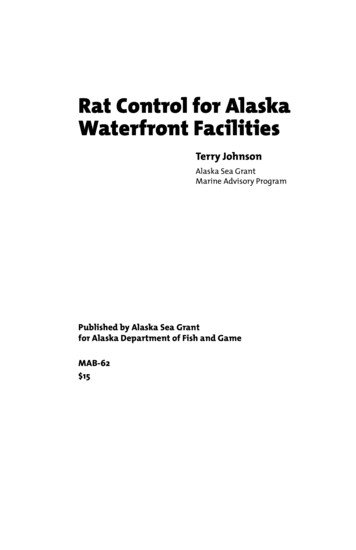
Transcription
Rat Control for AlaskaWaterfront FacilitiesTerry JohnsonAlaska Sea GrantMarine Advisory ProgramPublished by Alaska Sea Grantfor Alaska Department of Fish and GameMAB-62 15
Elmer E. Rasmuson Library Cataloging in Publication Data:Johnson, Terry Lee, 1947Rat control for Alaska waterfront facilities / Terry Johnson. – Fairbanks, Alaska : Alaska SeaGrant College Program, University of Alaska Fairbanks, 2008.p. : ill. ; cm. - (MAB ; 62)1. Rats—Control—Alaska. 2. Ratproof construction—Alaska. 3. Rat baits and repellents—Alaska. 4. Rodenticides—Alaska. 5. Waterfronts—Alaska—Health aspects. I. Title. II.Johnson, Terry Lee, 1947- III. Series: Marine advisory bulletin ; 62.RA641.R2 J04 2008ISBN 978-1-56612-130-9doi:10.4027/rcawf.2008CreditsThis book is published by the Alaska Sea Grant College Program, supported by the U.S.Department of Commerce, NOAA National Sea Grant Office, grant NA06OAR4170013,projects A/151-01 and A/161-01; and by the University of Alaska Fairbanks with statefunds. The University of Alaska is an affirmative action/equal opportunity employer andeducational institution. Funding for the publication is provided by the Alaska Department ofFish and Game, project no. ADN 1185083. (The funding agencies do not necessarily endorsecommercial products named in this book.)Sea Grant is a unique partnership with public and private sectors combining research,education, and technology transfer for public service. This national network of universitiesmeets changing environmental and economic needs of people in our coastal, ocean, and GreatLakes regions.Book design, layout, and cover design by Jen Gunderson, editing by Sue Keller, and art on pp.18, 35, 36, 42, 54 by Deborah Mercy of Alaska Sea Grant. Cover illustrations and photos onpp. 1 and 61 are from istockphoto.com.Alaska Sea Grant College ProgramUniversity of Alaska FairbanksP.O. Box 755040Fairbanks, Alaska 99775-5040Toll free (888) 789-0090(907) 474-6707 fax (907) 474-6285www.alaskaseagrant.orgAlaska
Table of ContentsAcknowledgments. viPart I: Technology and Methods1. Introduction. 3Alaska regulation. 52. Meet the Enemy. 7Norway rat. 8Morphology and physiology. 8Life history and behavior. 9Some handy rat facts.10Threats posed by rats.11Disease.11Infrastructure.11Wildlife.123. Integrated Pest Management.13Prevention, control, eradication.144. Inspections.17Go equipped.17What to look for.18Feed.18Harborage.19Burrows.19Travel routes and other high-activity areas.205. Sanitation Is Pest Control.23Rat control in seafood plants.246. Rodent-Proofing Waterfront Properties:Interdiction and Exclusion.27Planning.27Denying harborage.28Interdiction.29Stopping rats arriving by ship.30iii
Vessel operator tips.32Rodent-proofing buildings.347. Rat Traps.37Snap traps.37Defensive trap stations for Alaska conditions.38Plywood cubes.39Plywood boxes.39Barrels.40Defensive station tips.41Baited or unbaited traps.43Trapping strategies.43Rat control alternatives.448. Rodenticides.47Pesticide applicator agulants.50Nontarget species.51Use of rodenticides.51Bait stations.53Pellets, meal, and liquid baits.56Follow-up and record-keeping.58Tracking powder and fumigation .59Part II: Administering a Rat Control Program9. Overseeing Integrated Pest Management.63Three phases of a rat control program.64Rat control checklist for complying.6510. Developing a Rat Control Plan.6711. Standard Operating Procedures for WaterfrontFacility Rat Control.71SAMPLE Standard Operating Procedures (SOP).71Purpose.71Responsibility.71iv
Principles.72Record-keeping and reporting.72Inspections.72Rat control points.74Food.74Harborage.74Lethal control.7612. Contracting with a Pest Control Professional.77Selecting a PCP.77Local hire.78Writing a pest control contract.79Simplified rat control contract template.7913. Applying HACCP to Rat Control.8114. Outreach and Community Involvement.91Outreach “talking points”.92Some outreach tips.93Bibliography.95Glossary.99v
AcknowledgmentsThe author wishes to acknowledge the following people for their assistance indeveloping this publication:Poppy Benson, Education and Outreach Coordinator, Alaska MaritimeNational Wildlife Refuge, Homer, AlaskaDr. Bruce Colvin, Colvin Consulting, Melrose, MassachusettsDr. Robert M. (“Bobby”) Corrigan, Environmental Scientist for the Cityof New York and Principal Instructor, New York City Rodent ControlAcademy, New York, New YorkSteve Ebbert, Wildlife Biologist, Alaska Maritime National Wildlife Refuge,Homer, AlaskaEllen Fritts, Habitat Biologist, Alaska Department of Fish and Game, Divisionof Wildlife Conservation, Juneau, AlaskaLarry Jones, American Pest Management, Anchorage, AlaskaDale Kaukeinen, Vertebrate Pest Specialist, Kaukeinen Consulting,Wilmington, DelawareRonald S. Klein, Program Manager, Alaska Department of EnvironmentalConservation, Food Safety and Sanitation, Anchorage, AlaskaDennis Lassuy, Invasive Species Program Manager, U.S. Fish and WildlifeService, Anchorage, AlaskaRosemarie Lombardi, DMV, Environmental Program Specialist, AlaskaDepartment of Environmental Conservation, Pesticide Program, Wasilla,AlaskaLCDR Brian Prendergast, Medical Entomologist, Navy and Marine CorpsPublic Health Center, Portsmouth, VirginiaAlan Sorum, City Manager, City of Skagway, AlaskaArt Sowls, Wildlife Biologist, Alaska Maritime National Wildlife Refuge,Homer, AlaskaLawrence Treleven, President, Sprague, Tacoma, WashingtonJeffrey Weier, Technical Director, Sprague, Tacoma, WashingtonDr. Gary Witmer, Biologist, USDA/APHIS National Wildlife Research Center,Fort Collins, ColoradoThanks also to Karlette Sylvain, New York City Rodent Control Academy,New York, New York, for helping the author enroll in the academy.vi
Part I:Technologyand Methods
31.IntroductionThe rat is called the “third most successful mammal in the world”—after thehuman and the house mouse—because of its spread across the globe, itsadaptation to a wide range of environments, and its ability to thrive in closeproximity to its chief enemy and benefactor, man. The rat’s successes imposecosts on its hosts and neighbors: disease and contamination, destructionof food and other goods, damage to equipment and infrastructure, anddevastation of wild bird populations and other wildlife.The rat’s position in world order is so well established that it may besurprising to learn that there are still towns, ports, and islands that are entirelyrat-free. (See the map indicating Alaska’s infested and rat-free locations.) Thepurpose of this manual is to offer operators of waterfront facilities informationthat will help them to control the numbers of rats and suppress the movementof rats through waterborne commerce, so that those locations remain rat-free.
4Rat Control for Alaska Waterfront FacilitiesThe focus is on the Norway rat, which is much more common in Alaska thanthe roof rat and other nonnative species.This publication is intended to provide operators whose ports and facilitiesalready have rats with tools they can use to keep local rat populations as lowas possible, thus minimizing risks to human health and to property, includingequipment, buildings, vessels, cargo, and products.A regulation adopted by the Alaska Board of Game in 2007 (see sidebar)makes it illegal to transport or harbor rats and mice anywhere in Alaska.Operators of ports, boat harbors, fish processing plants, cargo terminals,and vessels transiting Alaska waters are bound by the regulation and may beprosecuted if rats or mice are found on their property. This manual can helpthose operators come into compliance.The chapters and appendices in this book offer information on thefollowing topics: The rat, its characteristics, capabilities, and threats. The principles of rat control and Integrated Pest Management. Specific control methods, including toxicants and traps. Establishing and managing a rat control program. Recommendations for vessels and food processing plants. Checklists for organizing site-specific rat control measures.While this book primarily targets Alaska ports, it is useful in waterfrontfacilities worldwide.
IntroductionAlaska RegulationIn 2007 the Alaska Board of Game passed the following regulationpertaining rodents in the family Muridae (Norway rat, roof rat, house mouse,and certain other invasives):5AAC 92.141. Transport, harboring, or release of live Muridae rodentsprohibited.a It is unlawful for the owner or operator of a vessel, vehicle, aircraft,structure being translocated, or other means of conveyance toknowingly or unknowingly harbor live Muridae rodents, or to enterAlaska (including Alaskan waters) while knowingly or unknowinglyharboring live Muridae rodents.b It is unlawful for an individual to release to the wild any live Muridaerodent.c It is unlawful for the owner or operator of a facility to knowingly orunknowingly harbor live Muridae rodents. The owner or operator of aharbor, port, airport, or food processing facility in which live Muridaerodents have been found shall develop and implement an ongoingrodent response and eradication or control plan.In addition, 5 AAC 92.230 Feeding of game reads: Except under termsof a permit issued by the department, a person may not intentionally feeda moose, deer, elk, bear, wolf, fox, wolverine, or deleterious exotic wildlife, ornegligently leave human food, pet food, or garbage in a manner that attractsthese animals. However, this prohibition does not apply to use of bait fortrapping furbearers or deleterious exotic wildlife, or hunting black bears,wolf, fox or wolverine under 5 AAC 84–5 AAC 92.5 AAC 92.990 defines “deleterious exotic wildlife” to include anyMuridae rodent.Violations are a Class A misdemeanor and require mandatory courtappearance (unless identified as a bailable violation). For individuals, penaltycan be a fine of up to 10,000 and up to one year in jail. For organizations(including businesses and agencies) the penalty can be a fine of up to 200,000 and up to three times the financial gain realized by the defendantas result of the offense, or up to three times the financial damage caused toanother as result of the offense.5
72.Meet the EnemyThe Norway rat (Rattus norvegicus) and the roof rat (Rattus rattus) aremembers of the family Muridae (mouse-like animals), which has about 500species. As rodents (derived from the Latin for “to gnaw”), they belongto the largest order of mammals, with 1,700 species. Norway and roof ratsshare many traits: they are commensal (“share the table” with us), relativelysecretive, nocturnal, and live by taking what they need from us. Norway rats areburrowing animals.The average size ofan adult Norwayrat is 16 inches long(including tail) and0.8-1.0 lb. SteveEbbert, USFWS.
8Rat Control for Alaska Waterfront FacilitiesNorway ratNorway rats are invasive species with origins in Asia. They’ve been on thiscontinent for more than two centuries. In Alaska, the Norway rat is believed tohave first arrived in the western Aleutians with Japanese or Russian exploringor trading vessels in the eighteenth century, and military shipping may haveintroduced it to ports in Southeast Alaska during the 1940s.Morphology and physiologyAll the Muridae have compact, flexible bodies suited to life in tight quarters.They can squeeze through any opening large enough to accommodate theirskulls. Their fur is sufficient to allow survival in fairly cold conditions, butthey do not thrive in the Arctic, and favor warmth where available. Long tailsprovide balance and leverage for climbing and jumping, and are used forthermoregulation (maintenance of body temperature) by radiating excessheat during warm weather. Hind feet have five toes with claws and front feethave four. Rats are powerful diggers.All have long incisors (front teeth) used for gnawing and can cut throughwood, plastic, wire, and even sheet metal. Their instinct for gnawing derivesfrom their diet in the wild of nuts, seeds, bark, and stems. They also gnaw toshred nesting materials; this urge to gnaw is the cause of much of their damageto materials and infrastructure.Rats are colorblind and their visual range is short, but their eyes areadapted for low light conditions and they detect motion at great distance. Theirsense of taste allows them to detect contaminants in food. Their hearing isgood—they can hear ultrasonic frequencies far beyond the range of humanhearing, allowing them to communicate and navigate in the dark ultrasonically.All have an acute sense of smell. As rodents travel through their habitatthey leave grease trails, as well as feces and urine, all rich in odors andpheromones (chemical substances that influence patterns of behavior inothers of the same species). By smelling the leavings of others a rodent can findpopular travel routes and food sources, and can determine the gender, state ofmating readiness, strength, and colony affiliation of individual animals.Muridae rodent movement is governed in part by thigmotaxis, whichmeans they orient their movements in their dark and complex environmentlargely through sense of touch. Vibrissae, including four specially evolved“whiskers” on the face and additional hairs on other parts of the body, serve assensory organs that allow them to feel and interpret the shapes of the spaces
Meet the Enemy 9and objects they encounter. With a sort of “muscle memory” they can retraceroutes originally developed with odor and touch cues.Life history and behaviorAll Muridae rodents mature at an early age, breed frequently, have shortgestation periods, produce multiple offspring, and have brief life spans. Somespecies breed year-round, but Norway rats are most prolific in spring and fall.In ideal conditions they can produce a new litter (four to ten young) everyfour weeks. A typical rat family is about eight individuals, including adults andyoung. While rats in laboratories may live several years, most rats living aroundpeople survive on average only about six months. A typical urban rat producesan average of 20 surviving offspring during its short life.Newborns—“pinkies”—are tiny, hairless, and helpless, dependent on theirmothers, and may die of hypothermia if she is absent for long or if they get wet.Rats live in colonies consisting of as many as 30 families, with establishedterritories, demarcated by scents and pheromones, which they defend withlethal force against intruders. An aggressive male dominates each colony andmay mate with dozens of females. Younger animals and less aggressive malesmay be forced out of the colony to attempt to establish new colonies, whichleads to traveling animals that find their way to places previously uninhabited.When there is plenty of food and shelter, rats in colonies may confinetheir foraging to a radius of only a few dozen yards. But all rats have an instinctfor exploration, and if their quarters become too crowded or their foodinsufficient, individuals strike out on exploratory journeys.Rats are omnivorous (eat both plant and animal material), and arescavenger, predator, and harvester of natural vegetation, all in one. Rats kill andeat birds and their eggs, small amphibians like frogs and salamanders, insects(including cockroaches), and each other, and they also consume seeds, berries,and other plant parts. They adapt quickly to eating grains, fish scraps, fruits,and other foods discarded or left accessible by people. Rats consume about 10percent of their body weight in food each day. Peak foraging is at dusk and justbefore dawn, but they may be active around the clock and sometimes forage inbroad daylight. Rats, unlike mice, require free water (1-2 oz) daily. The singlesurest determinant of rat location is a consistent food source.The other determinant of colony location is harborage or shelter. Ratsnest in burrows in the ground, in trees, rock piles, natural crevices, and so on.Around human habitations and infrastructure they burrow under sidewalks
10Rat Control for Alaska Waterfront Facilitiesand foundations and can inhabit virtually any part of a house or building,including sewer systems, basements, the spaces inside walls, stairwells, attics,and even furniture and desk drawers in working offices. They seek sources ofheat and like to nest near furnaces and machinery. They are unfazed by loudnoises or the presence of humans only feet or even inches away.They can climb up exterior or interior walls of buildings, walk on ropes,cables and electrical wires, scramble up downspouts, and jump from onestructure to another. They can squeeze through openings as small as a half inchand if there isn’t an adequate hole they can gnaw through timbers or siding, andeven metal in some cases.Although roof rats are common in the contiguous United States andare known to inhabit ports that serve Alaska, such as Seattle, San Francisco,and Los Angeles, they do not survive as well in Alaska conditions as Norwayrats. Therefore, this manual is intended primarily to address control andmanagement of Norway rats.Some handy rat facts Average adult size of a Norway rat: 16 inches long (including tail) and0.8-1.0 lb. Skull vertical height (and diameter of hole through which it can pass):0.5 inch. Age at mating: 8-12 weeks. Gestation period: 18-22 days. Average number of pups per litter: 4-12. Age at weaning: 10-15 days. Life span: 0.5-1.0 years in wild rats, 3-4 years in captive rats. Breeding season: year-round if environmental conditions allow. Home range radius if adequate food is available: 100 feet. Distance rats have been documented to travel in one day: 4 miles. Rats can leap upward as much as two feet, and can jump horizontallyfour feet. Rats can swim a half mile, can remain afloat up to 72 hours if water is nottoo cold, can dive and can swim underwater up to 30 seconds. Estimated annual cost of rodent control in the U.S. (1990s data): 337million, including more than 100 million for rats.
Meet the Enemy 11Threats posed by ratsDiseaseLong associated with fearsome diseases like bubonic plague and typhus, ratsare considered a serious threat to human health. In the last century some 100million people worldwide are believed to have died of rat-borne diseases.The history of rat-associated illness in North America is not as morbidas on some other continents. Evidence suggests that in the United Statesmore people get sick from contact with mice than rats. Hantavirus, Lymedisease, rickettsial pox, and a serious flu-like malady caused by lymphocyticchoriomeningitis virus (LCMV) are associated with exposure to wild ordomestic mice. Furthermore, mouse urine causes many difficult-to-diagnoseallergies, and there is a very high statistical correlation between exposure tomouse urine and asthma. (A mouse excretes 2,000-3,000 droplets of urine aday; it’s their main form of social communication.)That’s not to say that rats are without human health issues. An estimated14,000 people in the United States are bitten by rats each year, although mostrat bites are not dangerous. Rats carry fleas, ticks, lice, and mites. Rats areassociated with the spread of leptospirosis, salmonellosis, and other humandiseases caused by bacteria, viruses, and parasites. Rats spread E. coli andprobably are responsible for many cases of food poisoning. They elevate thelevel of bacteria in the human environment wherever they exist. In the UnitedStates, however, and especially in the northern latitudes, transmission ofserious disease from rat to human is not well documented.InfrastructureRats are very hard on buildings, equipment, and property. They tunnel undersidewalks, causing concrete to crack. They gnaw on walls, door frames,foundation skirts, and other structural features. They shred insulatio
Specific control methods, including toxicants and traps. Establishing and managing a rat control program. Recommendations for vessels and food processing plants. Checklists for organizing site-specific rat control measures. While this book primarily targets Alask
